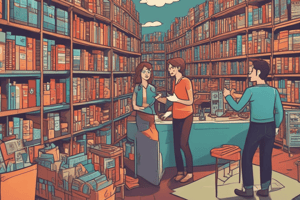Podcast
Questions and Answers
Which statement best describes consumer surplus?
Which statement best describes consumer surplus?
- The total amount spent by consumers in the market
- The surplus of goods available for sale at a given price
- The aggregate utility derived from purchasing goods
- The difference between what consumers are willing to pay and what they actually pay (correct)
What does cross-price elasticity of demand measure?
What does cross-price elasticity of demand measure?
- The overall demand shift caused by a change in consumer preferences
- The change in quantity supplied when production costs vary
- The effect of an increase in income on the quantity demanded of a good
- The responsiveness of quantity demanded for one good to the price change of another good (correct)
How does behavioral economics differ from traditional economic assumptions?
How does behavioral economics differ from traditional economic assumptions?
- It assumes that consumers have perfect information
- It only involves the analysis of supply and demand curves
- It disregards the role of emotions in consumer behavior
- It takes into account psychological factors influencing consumer decisions (correct)
What is meant by bounded rationality in consumer behavior?
What is meant by bounded rationality in consumer behavior?
What is a primary benefit of applying consumer behavior insights to marketing strategies?
What is a primary benefit of applying consumer behavior insights to marketing strategies?
Which term describes the limit on consumption choices determined by income and prices?
Which term describes the limit on consumption choices determined by income and prices?
What does the Law of Diminishing Marginal Utility state?
What does the Law of Diminishing Marginal Utility state?
How does the Demand Curve typically behave?
How does the Demand Curve typically behave?
What does an indifference curve represent in consumer behavior?
What does an indifference curve represent in consumer behavior?
What is Price Elasticity of Demand a measure of?
What is Price Elasticity of Demand a measure of?
Which factor is NOT included as affecting demand?
Which factor is NOT included as affecting demand?
What is the definition of total utility?
What is the definition of total utility?
Which of the following best describes consumer preferences?
Which of the following best describes consumer preferences?
Flashcards are hidden until you start studying
Study Notes
Microeconomics: Consumer Behavior
-
Definition of Consumer Behavior
- The study of how individuals make decisions to spend their available resources (time, money, effort) on consumption-related items.
-
Key Concepts
-
Utility
- The satisfaction or pleasure derived from consuming goods and services.
- Total Utility: Overall satisfaction from consumption.
- Marginal Utility: Additional satisfaction from consuming one more unit.
-
Law of Diminishing Marginal Utility
- As a consumer consumes more units of a good, the additional satisfaction (marginal utility) from each subsequent unit tends to decrease.
-
Budget Constraints
- The limit on the consumption choices of consumers, determined by income and prices of goods.
- Represents the trade-offs consumers face when making purchasing decisions.
-
Indifference Curves
- Graphical representation of different combinations of two goods that provide the same level of utility to a consumer.
- Slope of the curve reflects the consumer's marginal rate of substitution between the two goods.
-
-
Consumer Preferences
- Preferences are subjective and vary among individuals.
- Consumers rank different bundles of goods based on their personal tastes and preferences.
-
Demand and Supply Factors
-
Demand Curve
- Shows the relationship between the price of a good and the quantity demanded.
- Typically downward sloping: as price decreases, quantity demanded increases.
-
Factors Affecting Demand
- Consumer income
- Prices of related goods (substitutes and complements)
- Consumer preferences and tastes
- Consumer expectations about future prices and income
-
-
Elasticity of Demand
- Measures how much the quantity demanded of a good responds to changes in price.
- Types:
- Price Elasticity of Demand: Responsiveness of quantity demanded to price changes.
- Income Elasticity of Demand: Responsiveness of quantity demanded to changes in consumer income.
- Cross-Price Elasticity of Demand: Responsiveness of quantity demanded for one good to the price change of another good.
-
Consumer Surplus
- The difference between what consumers are willing to pay for a good and what they actually pay.
- Represents the benefit to consumers from participating in the market.
-
Behavioral Economics
- Examines how psychological factors influence consumer decisions.
- Challenges traditional economic assumptions of rational behavior.
- Concepts include:
- Bounded rationality: Consumers may make decisions based on limited information.
- Heuristics: Mental shortcuts that simplify decision-making.
-
Application of Consumer Behavior
- Helps businesses understand market trends and consumer preferences.
- Aids in crafting marketing strategies and product development.
These notes summarize the essential aspects of consumer behavior within the broader context of microeconomics, focusing on definitions, key concepts, and relevant applications.
Consumer Behavior Overview
- Study of decision-making processes regarding the allocation of resources on consumption items.
Key Concepts
-
Utility
- Satisfaction derived from goods and services.
- Total Utility: Overall satisfaction.
- Marginal Utility: Additional satisfaction from consuming one more unit.
-
Law of Diminishing Marginal Utility
- Continuous consumption leads to a decrease in additional satisfaction gained from each subsequent unit.
-
Budget Constraints
- Limits on consumption based on income and product prices.
- Illustrates trade-offs in purchasing decisions.
-
Indifference Curves
- Graph showing combinations of two goods that yield the same utility.
- The slope indicates the marginal rate of substitution between the goods.
-
Consumer Preferences
- Subjective and vary individually.
- Rankings of goods influenced by personal tastes.
Demand and Supply Factors
-
Demand Curve
- Depicts the relationship between price and quantity demanded, generally downward sloping.
-
Factors Influencing Demand
- Consumer income levels.
- Prices of substitutes and complements.
- Individual preferences and tastes.
- Expectations about future prices and income.
Elasticity of Demand
- Measures responsiveness of quantity demanded to price changes.
- Types of Elasticity:
- Price Elasticity of Demand: Impact of price changes on quantity demanded.
- Income Elasticity of Demand: Reaction to changes in income.
- Cross-Price Elasticity of Demand: Response of quantity demanded of one good to price changes of another.
Consumer Surplus
- Difference between willingness to pay and actual price paid.
- Represents the net benefit or value to consumers in the market context.
Behavioral Economics
- Focuses on the impact of psychological factors on consumer choices.
- Questions the notion of rational behavior in economic decision-making.
- Key concepts include:
- Bounded Rationality: Decisions made with limited information.
- Heuristics: Mental shortcuts for simplifying decisions.
Application of Consumer Behavior
- Utilized by businesses to analyze market trends and consumer preferences.
- Informs marketing strategies and product development initiatives.
Studying That Suits You
Use AI to generate personalized quizzes and flashcards to suit your learning preferences.




